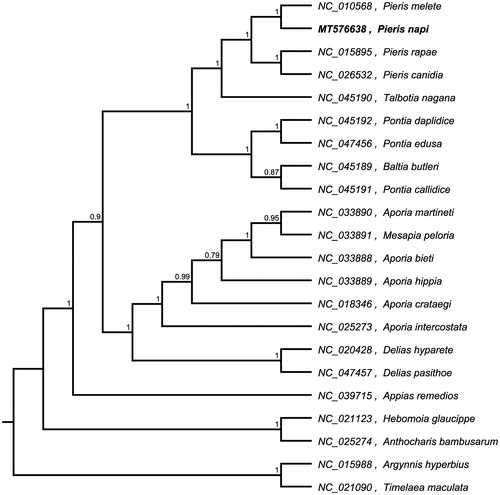Abstract
In this study, the mitochondrial genome (mitogenome) sequence of Pieris napi is determined using next-generation sequencing. The entire mitogenome genome is determined to be 15,178 bp in length. It contains 37 genes, including 13 protein-coding genes (PCGs), 22 transfer RNA genes (tRNAs), two ribosomal RNA genes (rRNAs), and an adenine (A) + thymine (T)-rich region. The overall GC content of the genome is 19.9%. A phylogenetic tree reconstructed by 22 mitogenomes reveals that P. napi is most closely related to Pieris melete.
Pieridae, including about 1200 species are distributed worldwide and their hosts are Cruciferae, Leguminosae, Cauliflower, and Rosaceae (Chou Citation1998; Häuser et al. Citation2005). Most of its species are vegetable or fruit tree pests. They are generally medium in size, lighter in color, most are white or yellow, and a few are red or orange (Kemp et al. Citation2005). The Pieridae plays a very important role in the field of systematic evolution research. However, due to the lack of genomic information, there is still some controversy about the classification and phylogeny of these taxa. To date, there is less information about the complete mitochondrial genomes (mitogenomes) of P. napi. In our study, the complete mitogenome of P. napi is determined, which would provide basic genome information for further genetic studies, phylogenetic analysis, and conservation of this species.
Total genomic DNA was extracted from the thorax muscle of a single individual butterfly (N21°98′73.12″, E100°91′17.29″) using the Sangon Animal genome DNA Extraction Kit (Shanghai, China). The voucher specimen was deposited at Southwest Forestry University (AMCFD: 1808). The whole-genome sequencing was conducted by Hefei Biodata Biotechnologies Inc. (Hefei, China) on the Illumina Hiseq 4000 Sequencing System (Illumina, Hayward, CA). The filtered sequences were assembled using the SPAdes assembler version 3.10.0 (Bankevich et al. Citation2012). Annotation was performed using the BLAST+ (Camacho et al. Citation2009 ) and tRNAscan (Schattner et al. Citation2005).
The mitogenome (NCBI acc. no. MT576638) of P. napi was determined to comprise double stranded, circular DNA of 15,178 bp containing 13 protein-coding genes (PCGs), 22 transfer RNA genes (tRNAs), two ribosomal RNA genes (rRNAs), and an adenine (A) + thymine (T)-rich region with 91.5% AT content. Among these, 14 genes were encoded on the L-strand, including four PCGs (ND1, ND4, ND4Land ND5), two rRNA genes, eight tRNA genes (tRNAGlu, tRNACys, tRNATyr, tRNAPhe, tRNAHis, tRNAPro, tRNAleu, and tRNAVal) and A + T-rich region. The remaining 23 genes are encoded on the H strand. The arrangement of genes is similar to all know Pieridae species. The overall GC content of the genome is 19.9%.
To investigate its taxonomic status, a maximum-likelihood (ML) was reconstructed based on whole mitogenome from 20 Pierinae butterflies and two outgroup butterfly (Argynnis hyperbius and Timelaea maculata) by Mafft version 7.0 and FastTree version 2.1.10 (Price Citation2010; Katoh and Standley Citation2013). The ML phylogenetic tree shows that P. napi is most closely related to Pieris melete, with bootstrap support values of 100% ().
Disclosure statement
No potential conflict of interest was reported by the author(s).
Data availability statement
The complete mitogenome sequence of Pieris napi is deposited in the GenBank database https://www.ncbi.nlm.nih.gov/ with the accession number MT576638.
Additional information
Funding
References
- Bankevich A, Nurk S, Antipov D, Gurevich AA, Dvorkin M, Kulikov AS, Lesin VM, Nikolenko SI, Pham S, Prjibelski AD, et al. 2012. SPAdes: a new genome assembly algorithm and its applications to single-cell sequencing. J Comput Biol. 19(5):455–477.
- Camacho C, Coulouris G, Avagyan V, Ma N, Papadopoulos J, Bealer K, Madden TL. 2009. BLAST+: architecture and applications. BMC Bioinformatics. 10(1):421.
- Chou IO. 1998. Classification and identification of Chinese butterflies [M]. Zhengzhou: Henan Scientific and Technological Publishing House.
- Häuser CL, de Jong R, Lamas G, Robbins RK, Smith C, Vane-Wright RI. 2005. Papilionidae–revised GloBIS/GART species checklist (2nd draft). http://www.insects-online.de/frames/papilio.htm. Accessed December, 2019.
- Katoh K, Standley DM. 2013. MAFFT multiple sequence alignment software version 7: improvements in performance and usability. Mol Biol Evol. 30(4):772–780.
- Kemp DJ, Rutowski RL, Mendoza M. 2005. Colour pattern evolution in butterflies: a phylogenetic analysis of structural ultraviolet and melanic markings in North American sulphurs. Evol Ecol Res. 7(1):133–141.
- Price MN, Dehal PS, Arkin AP. 2010. FastTree 2-approximately maximum-likelihood trees for large alignments. PLoS One. 5(3):e9490.
- Schattner P, Brooks AN, Lowe TM. 2005. The tRNAscan-SE, snoscan and snoGPS web servers for the detection of tRNAs and snoRNAs. Nucleic Acids Res. 33:W686–W689.

